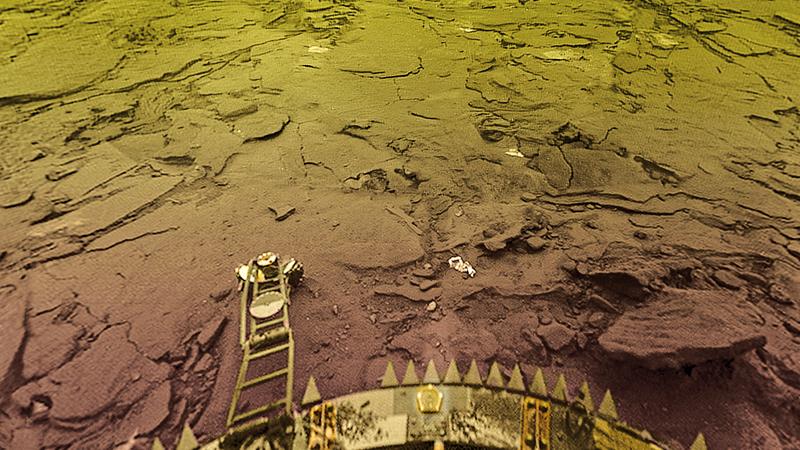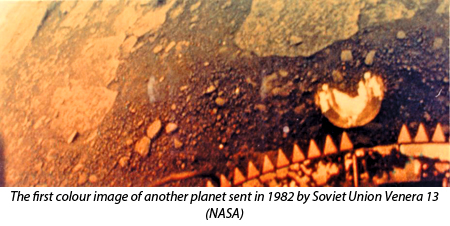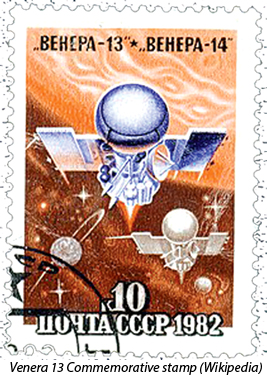
All eyes were on the recent highly publicised NASA Perseverance mission to Mars. While everyone watched in awe when Perseverance Rover sent its first clear colourful pictures of the surface of Mars, most of the world has forgotten that less hospitable and extremely hot planet Venus was reached by the Russians a long time before American NASA managed to send data from Mars.
 Even according to recent studies by NASA, the title ‘most habitable planet on Solar system’ went to Venus before our Earth. It is almost the same size as Earth, but its average temperature now is over 460 Celsius. It has a thick atmosphere due to greenhouse effect, which cannot host any known living being. It is also subject to atmospheric pressure 92 times than Earth and could crush any living animal to death.
Even according to recent studies by NASA, the title ‘most habitable planet on Solar system’ went to Venus before our Earth. It is almost the same size as Earth, but its average temperature now is over 460 Celsius. It has a thick atmosphere due to greenhouse effect, which cannot host any known living being. It is also subject to atmospheric pressure 92 times than Earth and could crush any living animal to death.
Once like Earth
Scientists believe Venus was once like Earth three billion years ago until about 700 million years ago, but what happened to it and why it became such an inhospitable planet is not yet known entirely. It possibly has had life a long time ago just like Mars. Scientists said that it was even cooler than Earth billions of years ago. It has been speculated by the UV absorbing patterns that its atmosphere contains microbial life even today. This is a startling discovery to some people who haven’t searched much about Venus as it is considered the hottest planet in our solar system.
It would be surprising to most people that many spacecraft have managed to land on this extremely hot, extremely pressurised inhospitable planet’s surface and managed to send data from it.
First colour image
The credit goes to the Soviet Union because Venus provides unique challenges. It was not easy for any country to send probes to its surface whereas the Soviet Union has stopped at nothing to send many probes to Venus, collected data and sent its first colour picture to Earth long before NASA sent colour pictures of Mars to Earth. As Venus rains sulphuric acid, the first attempt to fly by Venus was on May 19, 1961 by Russian ‘Venera 1’ had communication failure and NASA’s ‘Mariner 2’ did a successful flyby in 1962.
In 1965, Venera 3 became the first probe to enter the Venus atmosphere, but communications were lost. In 1967, for the first time, Venera 4 returned atmospheric data back to Earth while entering the atmosphere. The Soviet Union sent Venera 5 and Venera 6 in January 1969 with such success that both worked for over 50 minutes on the atmosphere sending data before melting in its extreme heat.
 On December 15, 1970 for the first time in our history, Venera 7 landed on Venus surface, marking it as the first soft landing. Venera 8 made history on July 22, 1972 with the first successful landing by a human-made space probe on the surface of another planet. Pushing its boundaries, the Soviet Union’s Venera 9 made into history books as the first man-made space probe to send pictures of the surface of another planet on October 20, 1975.
On December 15, 1970 for the first time in our history, Venera 7 landed on Venus surface, marking it as the first soft landing. Venera 8 made history on July 22, 1972 with the first successful landing by a human-made space probe on the surface of another planet. Pushing its boundaries, the Soviet Union’s Venera 9 made into history books as the first man-made space probe to send pictures of the surface of another planet on October 20, 1975.
Venera 13
The discoveries did not end there, as the Soviet Union made worldwide space enthusiasts’ jaws drop when their Venera 13 on March 1, 1982, sent the first recorded sounds from another planet when the space probe landed there and functioned well. Venera 13 had cameras to take pictures of the ground and spring-loaded arms to measure the compressibility of the soil.
Its quartz camera windows were covered by lens caps which popped off after descent which can be heard in the sound recording. This amazing sound recording of another planet is available on the internet for anyone to listen to. Viewers can see the first colour images it sent back to earth and can hear this man-made probe drilling into the ground of the extremely hot planet - Venus.
The drilling sound and sample collecting are clear while the wind can be heard moving so fast like on a hurricane day on the planet Earth, but our robotic space probe keeps working, drilling and analysing data in a heat that is about to boil its hard metallic gear soon. It is such a haunting sound to hear, with only the wind making the noise, with no other living being there under the sun.
Our probe works not just the expected 32 minutes, the planned designed life, it exceeds the limit by functioning for about 127 minutes in an environment temperature of 457 Celsius, sending such valuable data to mankind, finally before losing communication and dying on another planet succumbed to its extreme conditions. A postage stamp was issued on its memory and the great achievement.
Further data
Later on, Venera 14 also recorded images and sounds from Venus. Data analysis determined the average wind speed at the surface to be between 0.3 and 0.5 metres per second. The Soviet Union’s final Venera 15 and 16 also entered the orbit and functioned from 1983 till 1984.
When space travel was in its primary stages, there was not enough data to prepare for such disasters. Most space probes were destroyed in the environment. In 1961, the Soviet Union had to learn a few clues about the surface of this hot planet by analysing its disasters.
From 1961 to 1984, Russia sent many missions to Venus, more than half of them becoming victim to its harsh environment and yet Russia, as always the pioneers in space travel, achieved the unthinkable of sending first colour images and the first sound recordings from another planet almost forty years ago, at a time when space travel was in such a primitive stage, making monumental discoveries for mankind.
